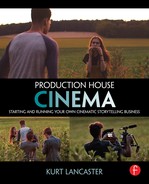URL of film: https://vimeo.com/112035686
Finding the Client
Sometimes potential clients see your work and then contact you about a job because they’re inspired by your work. Or perhaps you’ve worked with one client and through word of mouth that client recommends you to another client. More rarely a potential client is one of the subjects you’re interviewing for a documentary you’re producing. Patrick and Amina Moreau met Stephanie Henry during Stillmotion’s shoot of their feature documentary Stand With Me, a story about a girl, Vivian, who makes lemonade to help fight childhood slavery. Stephanie is in the documentary, Amina Moreau tells me. “We got to know her story. When she was nine she had a very different childhood than little Vivian,” Amina says. Stephanie would end up writing a book about an abusive past with her stepfather in If Only I Could Sleep (Emerald Book Company, 2014). “And so because of her past she felt like it was her duty, her responsibility to help her do as much good as she possibly can and so she became a big part of it.”
It was during the documentary shoot that Stephanie asked Stillmotion to do a trailer for her book. Even though they decided to approach it as a narrative project, Amina says, “It’s based on a true story and so we took that seriously. We really wanted to do it the justice that it deserved.”
Developing the Script and Taking a Creative Risk
As part of his research, Patrick Moreau read Stephanie Henry’s book and when he hit the section about an essay that she read to her high-school class at the age of fifteen, he called her up and said, “That essay is what will become your book promotion trailer,” Patrick recalls. “We’re not interviewing people, we’re not doing anything else, that’s too safe, that’s too easy,” he said. Using a narrative style for a promotional film was a risk Stillmotion took. They’ve done documentary-style promotions and even Emmy-Award-winning documentaries for the NFL in addition to the feature documentary, but these successes could lock them into a certain style in the minds of their audiences—and their potential clients. They’ve never tackled narrative storytelling before and they’re not known for that style.
Patrick discusses how after doing film workshops in 30 cities in North America and across five countries in Asia, he knows that Stillmotion will be judged. “You realize that there’s a lot of eyes on you, and you realize that as you venture into a new medium there’s a very good chance for a lot of people to look at you and say, ‘Yeah, you guys should have stuck to weddings,’” he laughs. “People are going to look at you—they’re going to ask those questions. Is this the next step? Or is this a step back? Or should they be doing this? Can they do this?”
It’s a risk to jump into a new project, a film that they could have shot in their compelling documentary style, a style their fan base understands, and they might say, “‘You should have interviewed people, that would have been better, that’s what Stillmotion does,’” Patrick confides. But at the same time, Stillmotion knows about story. “In a way we were reinventing ourselves in front of a lot of eyes and we needed to make sure that we did it in a way that stayed true to who we are, which is story first,” Patrick adds. And so he felt compelled “to make sure that this is right for us, that we can do this.” As he thought about the project, what went through his head was to make sure that after watching the film, “you felt like this is the right choice, that it felt strong. Because I think that has so much to say with our credibility as filmmakers and educators and storytellers, and if we do something we’ve never done before, and it doesn’t work, then that’s not good.”
In essence, Stephanie’s essay became the script for the book trailer (see Figure 8.1), making the trailer as personal as the book itself. Rather than just presenting the essay as a narration voice-over device or archival moment in a documentary film, they used it as the creative basis for a recreation of Stephanie’s life—from the creation of an early 1980s classroom to scenes from her past.
“The essay was perfect,” Patrick tells me. “It became the vehicle that would move people emotionally—it would allow them to see what Stephanie’s life was like and allow the audience to come to their own conclusion and it would hopefully create intrigue into who she was,” he adds. This could lead to more book sales for Stephanie. If the short film works, then, “If you want to know Stephanie better what are you going to do? You’re going to read her book,” Patrick explains. That’s the point of a promotional book trailer.
“Her essay was short enough,” Patrick adds. “It was simple enough and it was powerful enough and had enough of the story. It really touched on a lot that needed to be told while telling the story. And the irony or the magic of it— it’s Stephanie at fifteen or sixteen years old standing up and reading an essay, which is the whole point of her book—the message is speak up, say something about abuse.” The essay, he adds, is really the first time she actually said some thing about any of this abuse happening. “So it has a wonderful resonance to
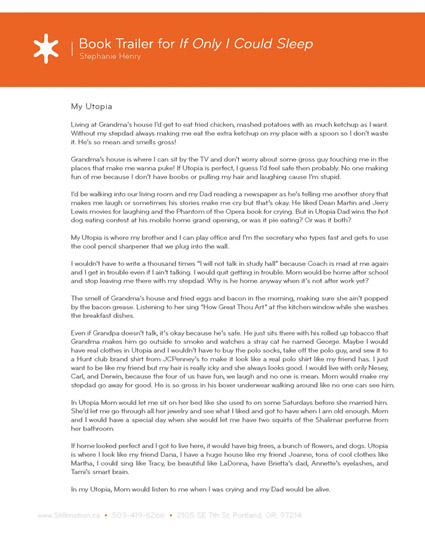
Figure 8.1 The script for “My Utopia” is the essay Stephanie Henry read in front of her high school class.
(Script courtesy of Stillmotion.)
The estimated budget for “My Utopia” is private, but the rough estimate places it between $50 and $100,000. (I’ve only provided estimated budget ranges for privacy purposes.) The estimated budget sheet from Stillmotion included the following:
Who we are
We’re a band of filmmakers and photographers who, as a rule, always let our curiosity get the better of us.
Frankly, we believe that the process of discovery is as important as what goes on the screen.
Relentless in our process. Passionate in the chase. We dig deep because we’ve seen the difference a story can make.
We got our start by filming weddings, and somewhere along the way, the NFL took notice of the magic happening on our team and gave us a call. This paved the road to producing a feature-length documentary for CBS, which went on to earn us three Emmy Awards and a substantial amount of storytelling cred.
We’ve racked up plenty of miles and hard drive space cooking up work for Apple, Canon, Callaway and CBS. Not that unabashed name dropping tells you much about who we are, but we’re pretty proud to have been trusted in some notable circles to tell some extremely powerful and diverse stories. We thrive on the uniqueness of everyone we meet and are fascinated by the impact that is made possible when people work together.
Be present. Ask questions. Share. Iterate. Connect. Dive. Dream. Repeat.
Overview
We all matter and we can make a real difference. Together we will explore your story through a narrative film that will serve as the book trailer but more importantly inspire others to stand up and do something.
Pre-production (low $10,000s)
3 days total of pre-production: 2 days with the director and DP to learn your story inside-out and then a 1 day pre-production with the whole team to do final tech prep and logistics. This includes casting, pre-interviewing, location scouting, ideation, sourcing and logistical planning.
Production (low $10,000s)
Timing: 2 days of production in the Portland area during the month of May 2014.
Resources:
- 1 Director
- 1 On-site Producer
- 1 Director of Photography
- 1 Cinematographer
- 1 AC
- 1 Field audio
- 1 Gaffer
- 4 Local Production Assistants
- All camera gear & lenses required
- All camera support required (including steadicam, dolly etc.)
- All lighting and grip required
Post-production (high $1,000s)
Deliverables:
One edited 2–3 min film delivered in HD, web-ready
All footage downloaded, sorted, and delivered via portable hard drive
Up to two rounds of revisions included
Color graded and sound mixed for final version
Soundtrack (Cost TBD)
1 year lifespan: 1–4 songs—$750 per track Perpetual lifespan: 1–4 songs—$1500 per track
Casting/Talent (mid $1,000s)
Stillmotion will handle all casting and talent acquisition for the film. We will screen and cast prior to production for all leading roles and extras needed.
Location Releases/Fees (mid $1,000s)
Stillmotion will take care of all location scouting and sourcing for the film. This includes location releases, fees, and set design.
Art Direction/Set Design (mid $1,000s)
Stillmotion will handle art direction, set design, and sourcing of props and wardrobe for the entire film as needed.
Travel
Stillmotion will do production for this project in Portland, minimizing the travel costs as the majority of the crew is based locally here. All travel plans for crew outside of Portland including all transportation, accommodations, meals etc. is included in this estimate.
Use/Rights
All rights owned by Stephanie Henry worldwide in perpetuity. Stillmotion also reserves the right to show the spots for promotional and/or educational purposes.
Final Project Estimate: Between $50 and $100,000.
her overall message and what she wants to encourage people to do. It doesn’t feel like a book trailer, it feels like a story.”
He told Stephanie about the plan. “I’m going to rebuild that day in 1981,” Patrick remembers telling Stephanie, and she was “so open and trusting and she just loved the idea,” Patrick says. But by taking the narrative approach (rather than shooting in a documentary style), he said, “I told her its going to cost a little bit more because we’re getting into props, costumes, locations, and a cast. But that it’s going to be way more effective and innovative. It’s a very different approach.” Stephanie agreed and they went forward into preproduction.
Planning the Intention, Keywords, and Storyboards
Despite trepidation about taking a new approach to a promotional film, Stillmotion’s experience in shooting live events (weddings), as well as their promotional and documentary projects, means that the Stillmotion team are confident storytellers. “The reality is that we take something like this on with a good budget and a good team and we know we can do something good,” Patrick tells me. “We have a certain level of confidence and certainly the approach and the effort and attitude that you know we’re going do what it takes to make something good.” But this approach—taking risks, taking on projects—only works if “it comes from within,” he says. “You need to be connected to it. You need to care about it. And we did.” If you’re doing a project just for the flash, just to get attention, just to get the views online,” he adds, “you’re rarely going to get to a good piece.”
As part of the preproduction planning for a narrative piece, they have more control of the set, the costumes, everything—much more so than a documentary or conventional promotional film. They could work with intention, Patrick says. “We were able to use our light, our lenses, our color, our soundtrack, every single element in a much stronger way.” If we go back to the four Ps (developed in their MUSE story process—people, place, purpose, plot), Patrick explains, we see that their educational model for telling stories is based on “intention.” “But that intentionality is in an event setting, and how you just think really quick.” In shooting an NFL game, they have to be fast on their feet and get the shot as it happens. There is no time to stage anything. So with “My Utopia,” they had more control over it. “Here’s an opportunity where we can produce everything,” Patrick smiles. “So it opened our eyes to how much further you can go with intention. Unlike a documentary, I can decide you’re going to wear a yellow dress, because yellow represents hope,” Patrick explains. “I’ve never been able to think about that before, but as we started having these conversations we realized how much deeper we can go.”
Patrick discusses this approach in more detail and it’s a lesson we can all learn when approaching production. It’s about listening. “Our whole storytelling approach, MUSE, the step-by-step process, is built on the idea of listening before you construct. So knowing what it is you want to say and defining that before you actually start saying it, is important. And so we come to keywords, we come to tools that help you know what it is you are trying to say.”
Keywords
Stepping back a moment, let’s take a look at the keywords the Stillmotion team created for “My Utopia.” The keywords they came up with are insightful, revealing the rationale behind their process in choosing and developing each:
Internalize
As she suffered several forms of abuse, Steph internalized the trauma as a feeling of no self-worth and that she was nothing more than her looks. This led to all of the trauma she then inflicted on herself— bulimia, drug addiction, selling her body. Her speaking is a way to bring all of this out to the world, and the way to heal.
Serve
She wants to share her story to help others. She is also using her story to drive her fight against sexual slavery across the world. She is using everything that has happened to her to serve others who have, or may suffer from the same realities that she did. She does frontline work across the world to help others and make sure they know they are cared about.
Despite all of the traumatic things Steph has been through (domestic abuse, failed education, rape, bulimia, drug addiction, losing custody of her daughter, life as a stripper, several marriages) she turned things around and is going back to school, treating her body right, in a great marriage, constantly growing and learning. She is a beacon of hope for others that you are valuable and can turn things around to build something better for yourself.
Speak
This book is her standing up and sharing her story. She believes that in speaking it will help her heal, and it will also let others know that they are not alone. By speaking she also believes people can deal with their demons, and only when they do that can they reach their full potential.
Emergence
The process of bringing to light after being concealed. That is what this book is. Emergence is also the idea that something is more than the sum of its parts. For Stephanie, she had the realization that she is more than just her body, the sum of her experiences, and she wanted to turn her life around.
(From internal Stillmotion document. Used with permission.)
Notice how each keyword goes back to what Stillmotion calls the “heart” of their story, the central character who expresses drives and needs, and provides the context for their mission for storytelling: to help improve the world. Other keywords they considered included truth, authenticity, numbing, worthless, potential, demons, vulnerability, looks, survivor, strength, and resilience. With the ones they chose above, we can see how the film would revolve around a sense of hope and change.
Heart of the Story
The Stillmotion MUSE process revolves around defining in a clear way who the central character is. During the listening phase of their work, they explore several viable characters, looking for levels of complexity, desire, and uniqueness. Here are their notes about what they discovered about Stephanie:
Complexity—the abused who recovers and fights to protect others.
- She grew up being taken advantage of, was made to feel worthless, and started treating herself the way others were (abusive, neglect). Not only has she found the strength to overcome this adversity, she now uses it to fight back and help other people who have suffered the same fate, and works to prevent it happening to others across the world.
Desire
- To have others feel like they are not alone.
- To really give back and serve others.
- To make sense of her story, to give it value.
- To let people know that they matter, that they have value.
Uniqueness
- Cute, blonde female who does frontline work.
- Doesn’t just donate money, goes to the organizations and wants to learn about it first hand.
- Poor family now very wealthy, let the money flow through her.
As can be seen, here, a documentary-style promotional film would have been easy for Stillmotion to produce—Stephanie, as herself, would have made a compelling character. But by taking that one moment from Stephanie’s life— the point where she shared her story about her abuse in high school—and making that essay the script, they took on a new type of challenge and would create a short narrative based on actual events. Although not all of this gets communicated through the film, the hope for the future—that sense of “the abused who recovers and fights to protect others”—as it ripples out through that personal essay becomes the narrative through-line for their story. But their storytelling process kept them anchored, and as they went into preproduction, they would build sets, costumes, use lighting, and develop storyboards to communicate their shots.
Storyboards
“And as you do that, as you have a set of keywords,” Patrick continues, “as you know who your main character is, as you know what makes them different, and as you know your story arc, you can then look at a set of storyboards or frames or shot list and ask, ‘How do I best communicate this?’” The keywords help them develop the visual story. And by extension, the storyboards shape the look and provide a way to set up a sequence and communicate that sequence to the production team. (See Figures 8.2–8.5.)
The storyboards from the opening scene of “My Utopia” reveal shots that are close to what was shot. The details on the storyboard include lens sizes and f-stops, as well as a description of the camera action and Stephanie’s action. The storyboard is a tool that allows everyone to be on the same page when setting up each shot. In addition, it allowed Patrick and the cinematographer, Joyce
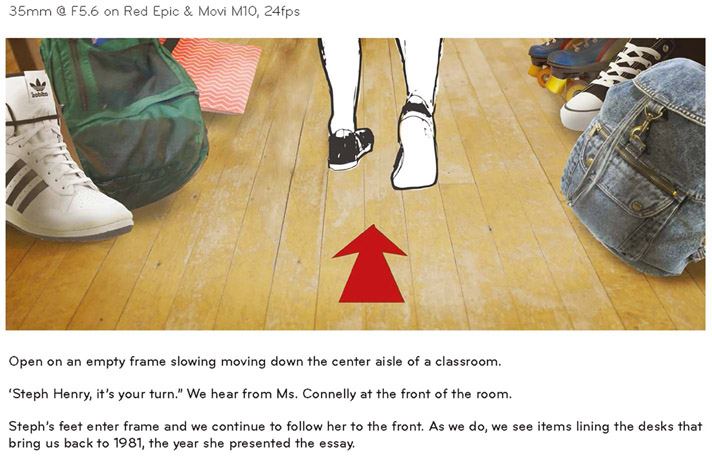
Figure 8.2 Storyboard of the opening sequence to “My Utopia.” Notice the stock photo is set as the background, while a drawing and graphic represents the main character and action. Also take note of the lens and f-stop setting, as well as the camera used and the frame rate. A brief description of the action is presented on the storyboards—in many ways we see the storyboard embedded in the script. (Courtesy of Stillmotion.)
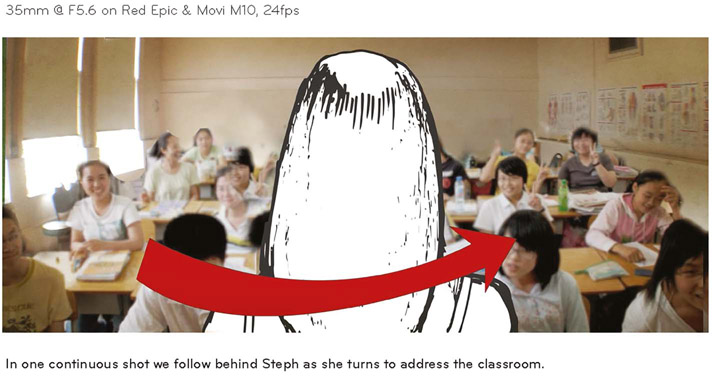
Figure 8.3 Storyboard of the opening sequence to “My Utopia.” Reverse angle of Stephanie. (Courtesy of Stillmotion.)
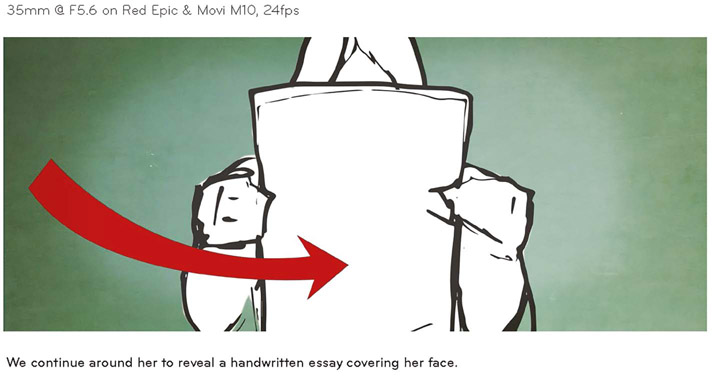
Figure 8.4 Storyboard of the opening sequence to “My Utopia.” The shot pushes in from the left as Stephanie holds her essay up, with a chalkboard in the background. (Courtesy of Stillmotion.)

Figure 8.5 Storyboard of the opening sequence to “My Utopia.” Stephanie reads her essay. (Courtesy of Stillmotion. Used with permission.)
Tsang, to look at potential shots on paper and ask themselves how they could go deeper into the story through the cinematography (such as choosing the right lens for a scene). The storyboard helped them previsualize the scene.
With the preproduction planning in place (their keywords, and the 4 Ps defined), they could then look at the classroom, for example, and discuss how they could light it. “How should we light the classroom that’s going to show both sides,” Patrick says, “that’s going to show the darkness and the despair along with the hope and optimism that she has at her age? What if we split light her so that it comes right across her face? How do we highlight her? How do we empower her? Because she’s standing up there and she’s saying something.” Notice how the shots closely reflect the storyboards (see Figures 8.6–8.8).
The Stillmotion approach didn’t change because they jumped into a narrative style; it reinforced their style. By asking questions based on the four Ps (people, place, purpose, plot) and the keywords, the heart of the story, they crafted the lighting to best reflect the story and character intention that emerged from their research.
Patrick continues the discussion: “Why don’t we have a slash of sunlight right across the chalkboard that frames her and comes into her and opens up as it reaches her body?” I feel like I’m in a master class with a filmmaker who approaches work in a unique way, a process that Stillmotion has shared with thousands of filmmakers and students around the world. “Because we know what we wanted to say we can keep asking those questions and we can just answer them. How do you do that with wardrobe? How do we make her feel this way? Well, it’s going to be a yellow dress, it’s going to look like this. We just kept asking those questions.”
These questions become the foundation for making decisions that were rooted in their research—research that in many ways developed from Patrick’s background in psychology. “As we worked through the lighting and the art direction and the camera movement, it was all motivation around these intentions,” he explains. “When we wanted to have the abusive stepdad come up the stairs, we really knew what that scene meant—and so we shot up on him making him bigger, making her smaller. Some of the short-sided composition feels super awkward. Joyce Tsang, our cinematographer, will actually start off the shots in a very comfortable composition where Stephanie is happy, but as she get anxious I can direct her to look out of frame and Joyce would tighten up the composition, making the shot become increasingly anxious and awkward as her performance and the story gets anxious.” (See Figures 8.9 and 8.10.)
In documentaries and event projects, Patrick explains, “we don’t tell people what to do. I can’t say as you’re doing your vows, ‘When you get here I want you to look up and smile.’ We can try to predict this as best we can, so it was amazing to be able to direct that in the narrative piece with five takes, where you’re getting a lot of these layers so that her wardrobe fits the story perfectly,
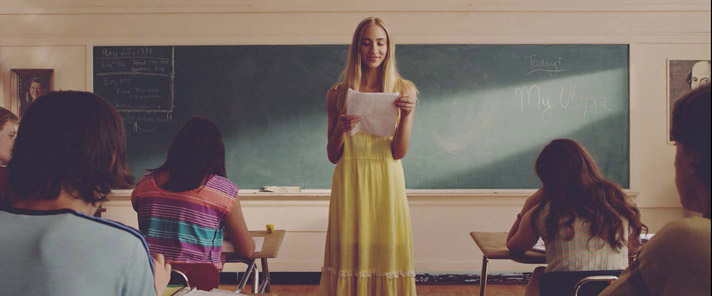
Figure 8.6 Claire Manning as Stephanie Henry in Stillmotion’s “My Utopia.” She reads an essay about her abuse in a 1981 classroom, recreated for a book promotional. Notice the lighting and the color of her dress—all of which is intentional to the story. “Why don’t we have a slash of sunlight right across the chalkboard that frames her and comes into her and opens up as it reaches her body?” Patrick asked. (Courtesy of Stillmotion.)

Figure 8.7 Reverse-angle close-up of Claire reading Stephanie’s essay in Stillmotion’s “My Utopia.” (Courtesy of Stillmotion.)
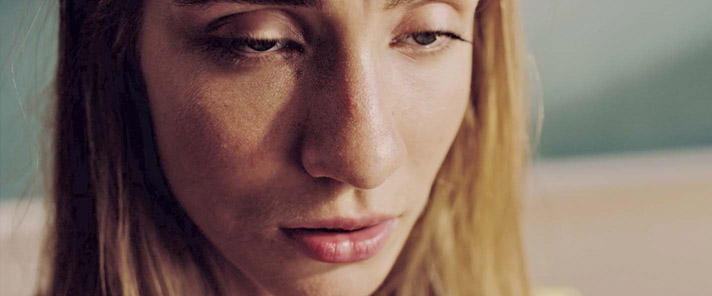
Figure 8.8 Close-up of Claire as she feels the pain from her abuse, foreshadowing a flashback in Stillmotion’s “My Utopia.” Notice the lighting designed to show her despair and hope. (Courtesy of Stillmotion.)
the lighting fit the story perfectly, and the composition is just coming in so also add that other layer. And then you’ve got your sound design and everything is working. We had never used MUSE with a narrative. It was awesome to see that it worked,” Patrick says. “That it really helped us and our team do a much better job with the story and all this intentionality. Working through that and applying that to a narrative gave us a new way for us to tell the story.”
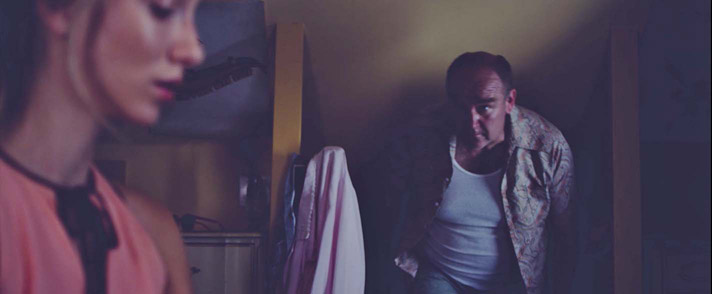
Figure 8.9 The lighting, the mood, is now darker: there is a loss of hope as the abusive stepfather (played by Mike Butters) climbs up the stairs to confront Stephanie in Stillmotion’s “My Utopia.” Notice how the lighting, focus, high angle, and framing build anxiety in the scene. (Image courtesy of Stillmotion.)

Figure 8.10 Over-the-shoulder shot looking down at Stephanie in Stillmotion’s “My Utopia.” The stepfather now looms overs Stephanie, who looks up in fear, feeling small and powerless. Notice the lighting on her face. (Image courtesy of Stillmotion.)
Production Plan
The production plan included an overview of the scene number, time allocated for shooting that scene, a brief description for the type of shot, the storyboard number it refers to, the camera gear needed (such as tripod and lens), the frame rate for the camera (such as 24fps or 96fps), the time of day, and a detailed description of the shot. (See Figure 8.11.)
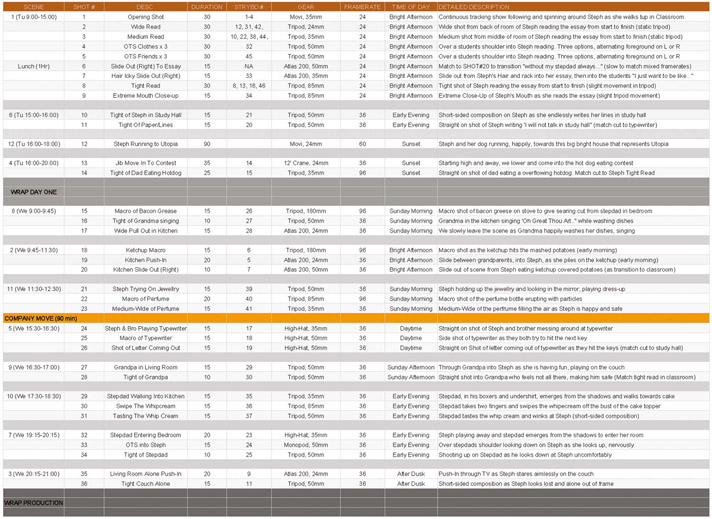
Figure 8.11 The production plan in one page for “My Utopia.” This is a key communication tool and a checklist for staying on schedule and knowing what needs to be shot and when. It can be checked off as shots are completed. (Courtesy of Stillmotion.)
Shooting, Slow Motion, and Composition in a Wide Aspect Ratio
Stillmotion chose the RED Epic in order to distinguish the look from many of their other projects (mostly shot on a Canon C100 and Canon DSLRs). “Making it look and feel bigger would make the story feel bigger, and that would be part of the draw in getting people to check out her book,” Patrick says in his blog about the project. The 5K and RED raw allowed them to engage in a stronger, deeper color depth (with a higher bit rate) than the 8-bit compression found in the C100 and DSLRs (see Chapter 7). With a larger bit-depth, they could also shape the look more strongly in post. (With 8-bit compression, the look tends to be burned in-camera since the image will begin to fall apart in post if you make changes to the color and exposure that are too wide. With the higher bit-rate of the RED, they were able to engage in stronger color-grading because the image contains more data to manipulate.) The RED also allowed them to shoot with dialed-in frame-rates.
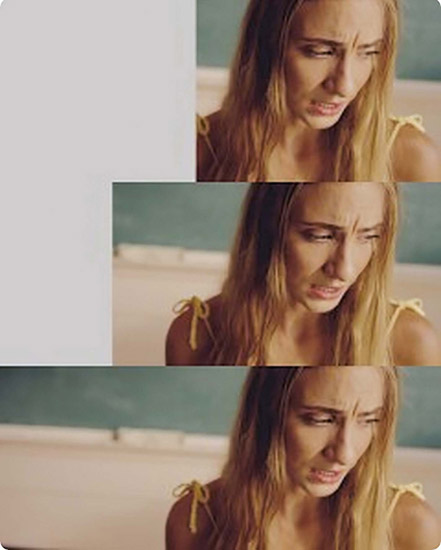
Figure 8.12 The 4:3 and 16:9 aspect ratios compared to 2.4:1 chosen for the film. (Image courtesy of Stillmotion.)
Typically, a film would be shot at 24 frames per second (fps), but with the RED, they were able to dial in a frame rate of 36fps. They decided to utilize the slower frame rate in all of the flashback scenes (Stephanie’s memories) in order to convey a different type of feeling than the classroom (shot at the standard 24fps). Patrick felt the 36fps1 “would give the flashbacks a bit of weight to them, a slight hesitation as the memory is being recalled, without being overly dramatic.”2 They would engage in an even higher frame rate to create moments of increased slow motion in order to accent moments of her memories in the flashbacks (such as the scene when Stephanie sprays herself with perfume).
They also made the choice to go with a super-wide frame aspect ratio for composition. A standard television frame is 4:3, while most cameras shoot in a high definition frame of 16:9. For “My Utopia,” they went with a 2.4:1 aspect ratio. The 2.4:1 aspect ratio gives the short film a feature-film look. In addition, Patrick says that in some shots, it helped create anxiety in the audience, since they would frame on the short-side of the frame, leaving more space to highlight that anxiety in Stephanie (see Figure 8.12).
In other scenes, Stephanie was placed towards the center of the frame in order to show her in balance, when she was happy. (See Figures 8.13 and 8.14.)

Figure 8.13 Stephanie, in soft focus, squeezes out ketchup. Notice that she is centered in the frame, revealing her as balanced and happy as she’s in a safe place. (Image courtesy of Stillmotion.)
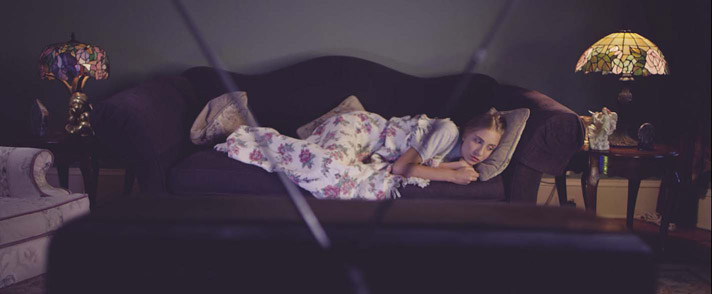
Figure 8.14 Stephanie at her grandmother’s house in “My Utopia,” a place of safety— the center composition reflects that balance in her life. This shot was planned in the storyboard, as seen in Figure 8.15. (Image courtesy of Stillmotion.)
The Art Direction and Set Design
It ended up being only a two-day shoot, but three months of planning went into the project. Brody Lowe did the art direction on the film. In discussing one of their keywords—hope—Brody says they intentionally made the classroom look drab and aged. “The only things that we wanted to have pop out was her dress,” Brody explains. “As a teen she’s reading this story, but she was still very hopeful about the future. And so that yellow dress was the thing that popped out—she was the hope, she was the nucleus to the story itself. There was always a light shining on her face whenever she was in the shot that, too, helped convey the idea of hope.” They also set up the classroom to indicate the timeframe of the film.
Here’s the location before the set design (Figure 8.16).
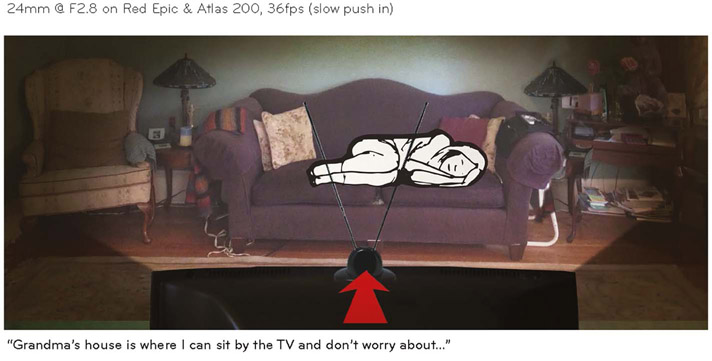
Figure 8.15 The storyboard showing the center composition that provides Stephanie a sense of balance (as she’s safe) at her grandparent’s house. (Image courtesy of Stillmotion.)

Figure 8.16 The classroom Stillmotion used for “My Utopia.” (Courtesy of Stillmotion.)
After bringing in set pieces and props (and costumed extras and the lead), and setting the lighting, it became a 1981-era classroom (Figure 8.17).

Figure 8.17 The detail of the opening set was shot in a medical school in Portland. They brought in old desks, used vintage clothing, and set up details (such as President Reagan’s photo) to help set the era. (Image courtesy of Stillmotion.)
Another keyword that helped set the art direction was emergence. “The idea of emergence involved a repetition and that led me to think of patterns,” Brody says. “So in almost all the shots you’ll see a pattern inside the shot. On the bed there will be a pattern bed spread. When grandpa’s in his rocking chair, he’s wearing a patterned shirt. There’s a pattern behind him—everything has to have pattern in it. That represents patterns in her life that kept on going and going. Those two keywords really helped move the art along quite a bit.”
In another example, when setting the look of 1981, Brody says that they avoided anything that was new in the 1980s. “So everything that was going to be in 1981 was probably purchased in the 1970s,” Brody says. So the clothes would be “a little aged.” They shopped in vintage stores in Portland to find the old clothing. But when it comes to hairstyles, they were definitely 1981, he adds.
Brody feels the creative process at Stillmotion—using the keywords to help inform their decisions—“really grounded where you could go with the look. In a way it created a collaborative environment where if you’re going to present a look or present an idea to make sure it fits. If it doesn’t fit then it shouldn’t be in there,” Brody adds. It helped ground the story.
Final Thoughts
In the end, Patrick feels the risk for shooting a promotional film in a narrative style was worth it. “The ultimate feeling that you want when you come out of this is that you are proud of it,” Patrick says, “that you feel you did the best you could do and then it is what you wanted it to be, what you feel it deserves. And we did it as a team. We certainly felt like this is the best story we have told up to this point.” They look forward to doing more narrative-style projects.
You can see Stillmotion’s “My Utopia” at: http://vimeo.com/112035686
As with any piece, the opening serves as your hook; it needs to pull you into the story and give the viewer a reason to want to watch. Present a bad hook and most people will switch off to something else, never seeing the full film.
The hook in “My Utopia” was designed to slowly bring you into the scene and the moment where Steph shares her essay. It’s a seventeen-second fluid shot that slowly reveals itself to you.
- The first few frames show you nothing but an old wooden floor along with desk and chair legs with kids’ items strewn about. Everything in the scene is old. Paired with the sounds of kids’ chatter and notebooks opening, we are immediately dropping you into what feels like a classroom, and one from long decades ago.
- A few seconds in, we hear the teacher call out ‘Steph, it’s your turn’ which introduces us to the main character as her feet enter the frame.
- We continue to follow her up to the front of the classroom and slowly rise the camera bringing a hand-written essay into frame. This starts to reveal the plot to us. Steph is heading to the front of the classroom to share some sort of report.
- As Steph turns around, we continue to rise up with the camera and reveal her face for the first time, full of hesitation and anxiousness as she takes the last few moments before she starts. The camera finally stops tight on her face and we live with Stephanie, feeling her hesitation and anxiousness until she begins by announcing the title of her essay, and the premise of the story “My Utopia.”
From “The Making of a Scripted Short—My Utopia” by Patrick Moreau (http://stillmotionblog.com/myutopia/)
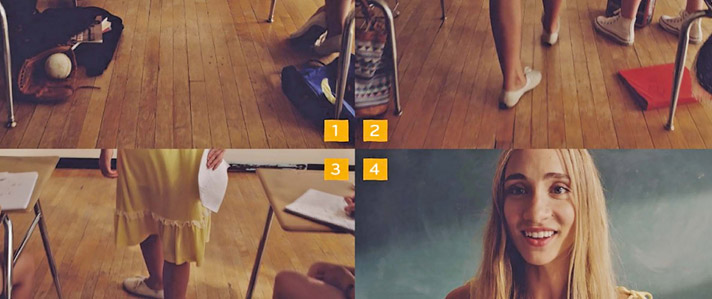
Figure 8.18 The sequence of shots in the opening scene from “My Utopia.” (Images courtesy of Stillmotion.)
